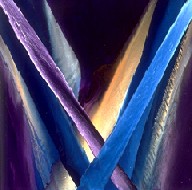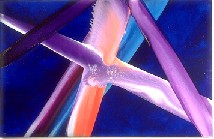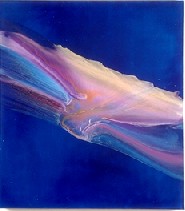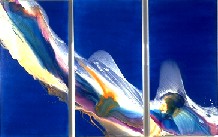Extending the Visible
John Haberin New York City
Alison A. Raimes
If you have encountered Alison Raimes for the first time just now, you are about to be taken in. She seems to hold out the raw immediacy of the Web, just as she herself has organized artists online. You start to forget her real gift—a painterly imagination that instant communication can never capture.
Alison puts deceptively familiar images right in front of you. Seductive purples and primary tones fill the painted rectangle completely. As in this image from her very latest series, Critical Inquiry into Chaos, there is no trace of the acrid colors of expressionism and the unconscious.  If the imagination runs free in these abstractions, it keeps coming back to an intense but very ordinary light.
If the imagination runs free in these abstractions, it keeps coming back to an intense but very ordinary light.
This has to be something natural, you want to say, something seen up close—a blade of grass, your private corner of the cosmos or the sea. It goes nicely enough with the translucency of an on-screen image. But is that all?
Sure, it takes the skill of an image maker, a painter after life. Black is rare, except in charcoal drawings. Color alone defines the edges and forms, as in so much of the best representational art since Modernism's birth. Strong yellow and white highlights suggest a strong, intense light source out in front—perhaps in your hand, part of the intense scrutiny she seems to allow. They lend things clarity and depth.
The backgrounds run to shadowy blues and other calm shades, like the sky or the sea. In fact, she confesses that she began painting seascapes. Like it or not, most people still think either of life forms or of something cosmic.
A moment's reflection will show just how wrong they are. How unfamiliar after all the image is. One starts to see how it earned a favorite title of hers, Mindescape, but the idea penetrates her newest and finest work as well. 
That moment of reflection taught me something else lost online, the size of these works. A painting that looked like a study under a microscope is five feet on a side. Imagined in its reality, it acquires the bare beauty of abstraction. Other images that somehow have ample room for points of ink-like detail, like a geode, run no more than a foot across.
Large forms also have a strange fineness, but in motion. In that new triptych, a wave seems to have moved from left to right. It bursts the bounds of a single panel, like an Asian screen. Yet it, too, is small. Artists like to distinguish size from scale, but here the distinction has a way of unsettling what I think I saw.
It is about time I got beyond the picture anyhow, to the painting. Alison says that she never starts with an image, but rather lets paint pour onto canvas. She works on the floor, adjusting her art to gravity and confined spaces. She even calls one series Spacescape. I think of Pollock's country shed—and an urban artist's studio rents ever since! 
As Alison goes back over her areas of colored paint, she works to enhance the sense of explicit process. In part, it is in the imagery. Some recent works, in a series called Intimate Inquiry into Nothingness, make me think of a crucible, in deep blue against a red background, pouring purple to the bottom of the canvas. In large part, though, one's awareness of process comes from the technique itself.
The medium mixes oil and resin, for a transparency a bit like watercolor but with a greater sense of physical layering. Alison may then pour on turpentine, causing the resin and pigments to part again. The form in that recent triptych from Critical Inquiry into Chaos starts at left, as a descending yellow. As it breaks across the borders set by the canvas, the white then surges vertically, acquiring smaller areas of intense color in front of it.
In an interview, Alison describes the technique in more detail. She works wet on wet, and she lets the paint take on its own texture as it dries, without repeated thinning. In this way resin gives the paint a varying thickness. If this indeed creates an imaginary landscape, she must know that the mind has mountains.
The surface, highlights, and interlaced colors amount to an unusual concern for detail and skill in a method easily written off as "free association."  You can see the careful drawing still more easily in charcoal sketches, which have the shallow depth and bold arcs typical of Russian Constructivism. Some paintings in the Mindescape series have the regular horizontals of a strong implied grid.
You can see the careful drawing still more easily in charcoal sketches, which have the shallow depth and bold arcs typical of Russian Constructivism. Some paintings in the Mindescape series have the regular horizontals of a strong implied grid.
I keep coming back to that paradox—process and skill, image and abstraction, the artist inside an act of pouring and an artificial, film-like medium. I can think of the work as representation after all, but representation of paint in its motion.
I sometimes associate the imagined lighting with the lights of the room as they pick out the actual painting. I think of that space imagined and real, transparency and paint, as a place for discovering my perceptions.

I wrote this for Alison Raimes's Web site, which contains images of her latest work, the interview mentioned here, and contact info. All images owned and copyrighted by Alison A. Raimes.




